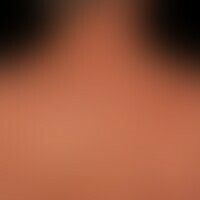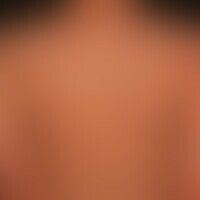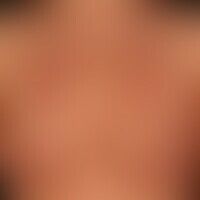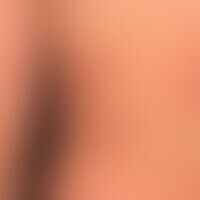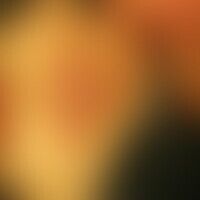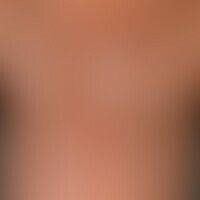Image diagnoses for "Torso"
551 results with 2173 images
Results forTorso
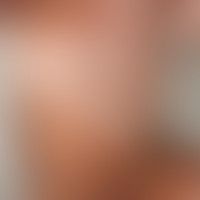
Nevus melanocytic congenital D22.-
Large congential melanocytic nevus (LCMN): no neurological sympotaxis detected (see below melanosis neurocutanea).

Nummular dermatitis L30.0
Nummular dermatitis: Extensive eczema that has been present for several months, with blurred papules and confluent plaques; distinct itching.

Lichen planus exanthematicus L43.81
Lichen planus exanthematicus: for several months persistent, itchy, generalized, dense rash with emphasis on the trunk and extremities (face not affected). 0.1-0.2 cm large, rounded, brown to brown-red papules with a smooth surface appear as single florescence. Here confluence to larger plaques.
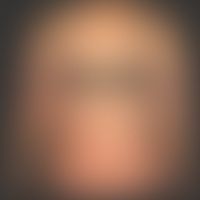
Pemphigoid gestationis O26.4
Pemphigoid gestationis: Intensely itching exanthema since 4 weeks with multiple, generalized, symmetrical, truncated, large red plaques with isolated, bulging blisters.
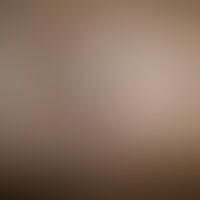
Herpes simplex virus infections B00.1
Herpes simplex virus infection: detailed picture with grouped and confluent vesicles.

Skabies B86
Scabies: Massively itchy clinical picture with disseminated, pinhead- to lenticular-sized, centrally eroded papules on the trunk and extremities.
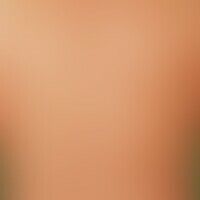
Xanthoma disseminatum E78.2 + Xanthoma disseminatum
Xanthoma disseminatum: chronic form of xanthogranulomatosis with symmetrically distributed, here truncated, symptomless, red-brown, surface-smooth papules.
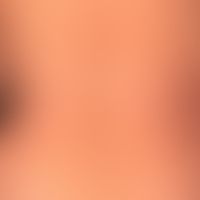
Lichen planus exanthematicus L43.81
Lichen planus exanthematicus: for 3 months persistent, itchy, generalized, dense rash with emphasis on the trunk and extremities (face not affected); on the cheek mucosa there are pinhead-sized whitish papules; as an individual florescence a 0.1-0.2 cm large, rounded, brown to brown-red papule with a smooth surface appears.
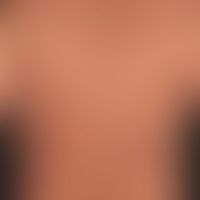
Erythema gyratum repens L53.3
Erythema gyratum repens: Anular, also garland-shaped, slightly infiltrated, reddish-brown plaques, sometimes scaly. No itching. Known bronchial carcinoma.
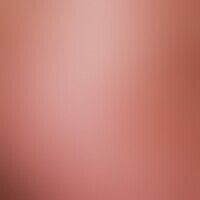
Pityriasis lichenoides chronica L41.1
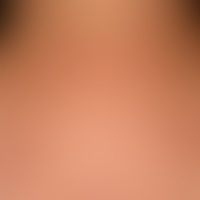
Teleangiectasia macularis eruptiva perstans Q82.2
Teleangiectasia macularis eruptiva perstans. 58-year-old patient with a generalized, spot-like clinical picture which has existed for many years and shows a constant progression; itching during sweat-inducing efforts and mechanical exposure of the affected skin areas.

Basal cell carcinoma superficial C44.L
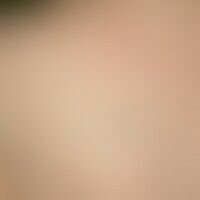
Keratosis seborrhoeic (overview) L82
Verruca seborrhoica: General view: For many years a 7 x 5 mm large, brown-black tumor on the left scapula of an 83-year-old female patient.
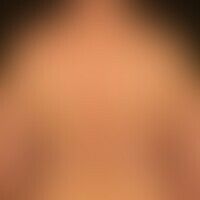
Atopic dermatitis (overview) L20.-
atopic dermatitis: eminently chronic dermatitis, with blurred, itchy, red, rough, flat plaques. known (only slightly pronounced) rhinoconjunctivitis allergica. IgE normal. no atopic FA. DD: a seborrhoid form of psoriasis can be excluded . R morphologically, a tinea corporis should be considered.
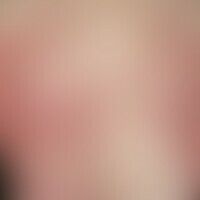
Drug exanthema maculo-papular L27.0
drug exanthema, maculo-papular. multiple, acute, since 4 days existing, generalized, symmetrical, initially isolated, 0.1-0.2 cm large, later on large, about 30 cm large, homogeneous, marginally bizarrely dissected, smooth, red spots. no fever, no lymphadenopathy. occurs 6 days after taking non-steroidal anti-inflammatory drugs due to a sports injury.

